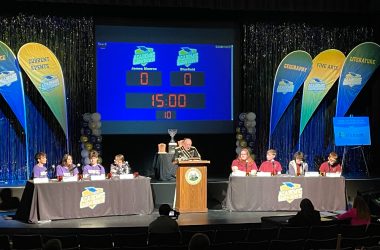By LINDA HARRIS
The State Journal
CHARLESTON, W.Va. — Growing up, Nickie Flare knew better than to tell her grandmothers she wasn’t feeling well.
Her grandmother Altie McIe lived in Webster County on an isolated property — a farm you could get to only by crossing a swinging foot bridge or fording the river if it was low enough. Her other grandmother, Isa Flare, didn’t live on a farm, but she still managed to grow all her own vegetables and harvest greens for her own home remedies on her Webster County property.

(Submitted photo)
“When it came to a remedy they needed, my grandmothers didn’t run to the pharmacy; they went to their larder,” Nickie Flare said. “(But) as far as I know, they only mixed remedies for the family.”
“(If you told) Grandma McIe you had a sore throat, she was boiling yellow root and you were gargling with it,” Flare said, describing that particular concoction as “nasty.”
“They were women who would pick dandelion greens and cook them,” she said. “They knew which were weeds and which were greens; I would go out with either one of them and pick greens. My dad still eats poke greens to this day. We still pick them.
“I don’t eat dandelion greens, but they were the kind of women who did that. They were also the kind of women who raised their own gardens and canned their own foods — they were pretty self-sustaining.”
Flare, who makes her living marketing Custard Stand products, hadn’t really thought about her grandmothers’ home remedies until a couple of years ago, when she watched a friend’s daughter struggle with eczema.
“I was looking for a way to help her that didn’t put a lot of chemicals in her body,” Flare said. “She was only 5 at the time, and if you’re looking at a whole lifetime of using steroids for eczema, that’s a long time. Stuff can accumulate in your system and cause a lot of side effects — hair growth on your arms where you don’t want it, for example. And some of the medicines for cold sores may not be good for the liver. So I went back to the way my grandmothers used to do things.”
Flare figured if she and her cousins had made it to adulthood on a steady diet of home remedies, those same remedies could help her young friend. So she started researching, reading everything she could find online and peppering relatives old enough to remember their grandmothers’ “old” ways with questions.
“It’s not something everybody’s going to do,” she said. “I’d picked greens with both my grandmothers, so I knew what to pick and what not to pick. Then again, there are field guides, so if you have a question you can always look it up.”
Flare said she just had a feeling there were natural ways to help the girl that wouldn’t overload her system with bad things.
“Not that (modern) medicines are not good, but I didn’t want her to use them unnecessarily,” Flare said. “So I did my research and talked to relatives, then we planted some flowers. She got to harvest them with me, so she got to be part of the process as well.”
Flare grows her own “active” ingredients — the greens and flowers that are the heart of her business. Some, like calendula, have to be thoroughly dried before she can use them in her balms, so she’s processing last year’s crop now. Calendula’s medicinal qualities help clean and heal cuts and wounds, but it also has anti-bacterial, anti-fungal and astringent properties, making it perfect for topical skin balms.
She locally sources beeswax, another staple she relies on for its antibacterial and antimicrobial qualities, pointing out, “It’s basically a miracle. It holds medicine on wounds and allows the skin to breathe.”
When she needs essential oils, she orders them, pharmaceutical grade, because she can’t do them herself.
“I do use natural ingredients as much as possible, things that can be obtained here,” she said. “Calendula flowers are the most healing ingredient in my eczema balm; I raise them in my own garden. There is an ingredient, lavender oil, that I can’t distill myself, so for the essential oils, I buy pharmaceutical grade. Everything else my grandparents could have grown in their garden.”
Even with all she’d learned from trudging along behind her grandmothers, there was a learning curve: Her first batch of Flare Bare Balm for eczema was far from perfect. She kept trying, though.
“It was not the consistency we needed,” she said. “The calendula concentration in the infusion seemed to be right, it worked — but it was much greasier and runnier than I wanted, almost more of a lotion consistency. But after I got the formula down for the balm, the products-to-wax ratio, the balm has been consistent.”
Once she figured out how to make her eczema balm, she started working on one for cold sores which, in turn, led to other products and a home-based business, Flare Bare Balms. At the moment, she has three products — an eczema balm, a cold sore balm and a wood balm — plus a fourth, an anti-bacterial balm for everyday skin wounds that’s still in development. All of them have developed a following.
“I’d decided the eczema balm was working so well, I figured I’d also do a cold sore balm,” Flare said. “There’s nothing that really cures the herpes virus that causes cold sores, but it can decrease outbreaks quite a bit. She uses both products for maintenance and during outbreaks, she has a lot less outbreaks when she uses both products regularly.”
Last Christmas, a hard-to-buy-for friend wanted wooden spoons, so Flare got them for her, along with a handmade cutting board. “Then I remembered my grandmother using a wood balm on those kinds of things,” Flare said. Before long she’d perfected a wood balm and gave some to the owner of the shop where she’d found the cutting board, Susie Burdette of Country Potpourri in Mt. Nebo, “and she loved it, so she asked me to bring some to an open house. She sold everything I (took) and ordered more,” Flare said.
Making the balms is a time-consuming process, she said, “but it’s worth it to me because I know exactly what I’m putting out there.”
“It’s hard to say how long a batch takes,” Flare added. “It’s going to be all summer before we get a batch from what’s coming out of the ground now. To actually put the balm together — the oils infuse for weeks; it’s a very long process. Once the product, whatever it is I’m using … calendula, lemon balm, whatever … is picked, it has to dry for days.
Her products are currently sold at Country Potpourri as well as the Addison Visitor Center in Webster County, so the business is still small enough she can do everything from home. Eventually, though, she hopes to see it expand to retail locations throughout West Virginia, which would require a bigger operations base.
“The Addison Visitor’s Center … is always happy to bring into the store locally made products,” Flare said. “Once the manager … knew that I was making these balms, she asked me to bring some in for her to sell as well. The folks of Webster County who have tried any of my balms are so great about telling other folks about it and where to get it.”
Long-range, she said she wants to grow her business — but she’d prefer to build her business through brick-and-mortar sales rather than online.
“I work seasonally, basically,” she said. “I have plants I’m infusing at this time for my Boo Boo balm. I’ll do that until the next thing grows to harvest. When my calendula flowers bloom, I’ll be able to dry them and put them away. But it’s not my schedule at all. It’s mother nature’s — and if I want to continue to do things on my own and as locally as possible, that’s the way it has to be; if I want to continue to do things from start to finish, I just have to work on mother nature’s schedule. That’s important to me.”
Flare points out she “can’t and (doesn’t) cure anything; I just pull some stuff from nature that helps.”
Drawing on her memories of her Grandmother Flare and Grandmother McIe is just the icing on the cake.
“The earth provides for us things that we’ve forgotten in our race to progress — we’ve forgotten a lot of things that are under our feet or growing on the river bank,” she said. “I guess it was one of those things where you grow up thinking, ‘that’s how things are done.’
“I got away from it for a lot of years — I was living in Ohio, working, a single mom raising my son. It wasn’t something I always did. But when you love someone, you want to make their life better — this little girl that I loved, it made sense to me to try and do something for her the natural way. Living in the woods, all this stuff is here, so it makes sense.”
Flare said the old ways of doing things still have value.
“People don’t appreciate the old ways as much as they used to,” she said. “But people survived for generations on those old potions, and without the side effects and other things you have,” when you rely on modern medicines.
“My job is marketing, so I have to embrace technology and work with it every day,” Flare said. “But I still like to embrace the old days. I feel like I’m keeping a little of my grandmother and my aunts with me. It keeps (their spirit) going.”
See more from The State Journal





